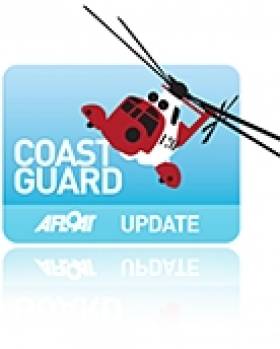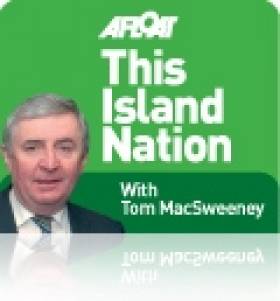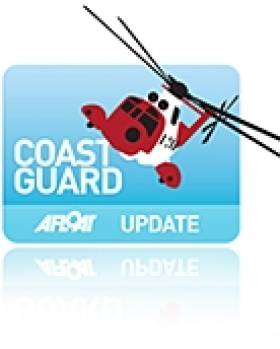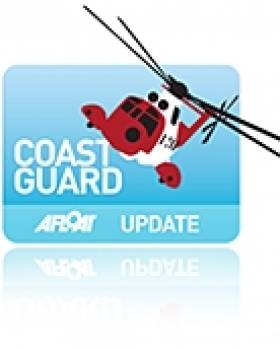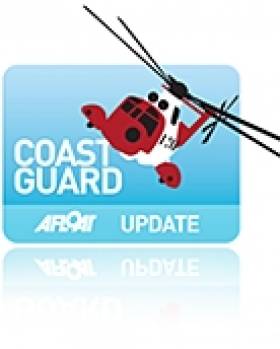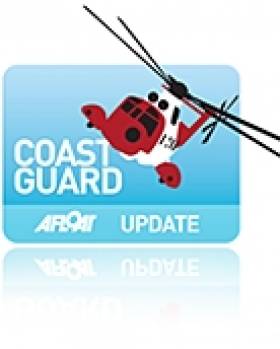Displaying items by tag: Coast Guard
Fishermen Rescued after Vessel Sinks off County Down Coast
#coastguard – Two fishermen have been rescued after the fishing vessel Snowdonia sank approximately 12 miles east of Kilkeel Harbour on the County Down coast.
Belfast Coastguard received a call from the fishing vessel Tribute reporting that they had recovered two fishermen from the water. The RNLI lifeboat from Kilkeel and the Irish Coast Guard Search and Rescue helicopter were sent to the scene. The crew of Kilkeel Inshore Lifeboat were quickly on scene and provided first aid until the arrival of the Irish Helicopter.
The two crew were airlifted to Daisy Hill Hospital, Newry where they are currently being assessed.
Gary Young, Watch Manager Belfast Coastguard, said: "This incident has again proved the importance of wearing a lifejacket and having it maintained to a high standard.
"I would like to pass on my thanks to the professionalism of the lifeboat and helicopter crews."
Additional reporting from RNLI:
The volunteer lifeboat crew with Kilkeel RNLI were today involved with a local fishing vessel and the Irish Coast Guard helicopter from Dublin in the rescue of two fishermen after the boat they were in sank off the Down coast. The men were ten miles from Kilkeel when the boat started to take in water and the alarm was raised.
Kilkeel RNLI received the call for assistance at 10.30am this morning (Tuesday 23 October 2012) and immediately launched and made their way to the scene. When the lifeboat crew arrived the vessel had sank and the two men had been taken onboard another fishing vessel, which was in the vicinity and able to respond to the callout. The fishermen had been in the water for a few minutes before they were pulled to safety and were feeling the effects of the freezing cold water.
A lifeboat crewmember from Kilkeel RNLI was transferred onto the vessel where they administered first aid and oxygen to the freezing men. On the arrival of the Dublin Coast Guard helicopter the two men were airlifted onboard and taken to Daisy Hill Hospital in Newry.
Commenting on the callout Roy Teggerty, Kilkeel RNLI Lifeboat Operations Manager said, "The two fishermen were extremely lucky. Thanks to the quick action of the passing fishing vessel along with the Kilkeel RNLI lifeboat and Dublin Coast Guard the men were recovered from the water very quickly and received first aid. I wish the men a full recovery from their ordeal.
Isle of Man Kayak Girl Brought to Safety
#rescue – A 7-year-old girl was rescued from the bay at Derbyhaven yesterday afternoon after being swept offshore by southwesterly winds.
The Marine Operations Centre based at the Isle of Man contacted Liverpool Coastguard at 1.26 pm to let them know that they been alerted to a young child being blown offshore in a sea kayak. The mother of the child had swam approximately 100 metres out to try and rescue the girl but was not able to reach her and was forced to turn back.
Liverpool Coastguard requested the launch of the Ronaldsway Airport Inshore Rescue Boat and the Port St Mary RNLI lifeboat, along with sending the Castletown Coastguard Rescue Team. Concerned that the child might get swept out of the bay, Liverpool Coastguard also contacted the HSC Manannan Ferry and asked them to keep a visual of the child at a safe distance to ensure she was not swept out further.
Two other sea kayakers on scene attempted to rescue the child but all three ended up on the rocks. The Ronaldsway Airport Inshore Rescue Boat then brought the girl and her kayak back to shore.
Volunteers in the Castletown coastguard team spoke to the parents of the girl and gave some safety advice about the dangers of offshore winds.
Paul Parkes, Liverpool Coastguard Watch Manager said:
"When undertaking any leisure activities on the water with young children we would always recommend that they are accompanied by a capable adult. As this incident shows, offshore winds can be extremely hazardous to children in inflatables or any craft where they are not able to make it back to shore unaided."
Rambler Crew Thankful, A Story of Two Vessels, Our Paralympians and Cork's New Pilot Boat
The Rambler Crew thank Valentia Radio for saving their lives in the Fastnet Race, but Coast Guard management wants to shut the station .... My story of two vessels ... John Twomey's Parlaympian achievements ... Cork gets a new Pilot Boat and ... trying to make ship-boarding pilot ladders safer ... There's a lot about boats in this week's TIN ..... Read on ....
SAVING LIVES MATTERS MOST – NOT FINANCIAL CUTBACKS
August 15 this year marked a very special day for the crew of the yacht Rambler 100 – they were still alive and they celebrated that fact – and they sent from New York an Email to the staff of Valentia Radio Coastal Station in Kerry. Coast Guard management in Dublin has a proposal to shut down the station and transfer its work to Dublin, to the constituency of the Minister for Transport, as a support station to the main Dublin base!
On August 15 the Rambler 100 crew Emailed to the staff at Valentia Island Maritime Radio Station:
"Today marks the one-year anniversary of our unfortunate accident during the Fastnet Race. Each Rambler crew member has his own story of what happened during this time of distress, however, the one thing that we share is the gratitude we feel for the Valentia Island Coast Guard. The professionalism of the Valentia crew and the diligence in alerting all authorities for our successful rescue is the reason we are here to share in the celebration of survival today. Tonight at 5.42 p.m. New York time the Rambler team will gather together and raise our glass to the sea and send out our thanks to our new friends in Ireland. Gratefully yours, Wendy, George and the Rambler 100 Crew."
Not much more needs to be said about the importance of Valentia Island Coastal Radio Station and its continued operation. It has a long history of saving life at sea in addition to its other operations.
I have asked for an interview with the Director of the Coast Guard Chris Reynolds, to find out exactly what is going on with the management proposals and why they want to centralise operations in Dublin. One proposal is that a support base to the national centre in Dublin should be located Blanchardstown, which just happens to be in the constituency of Minister for Transport Leo Varadakar who will have the final decision to make on the future of the coastal radio stations at Valentia and Malin and who has already indicated that "tough" decisions will be taken.
Again, the question has to be raised, as it was when then Minister Dempsey sought to close Waterford SAR rescue station – How much is a life worth?
TWO BOATS – TWO STORIES
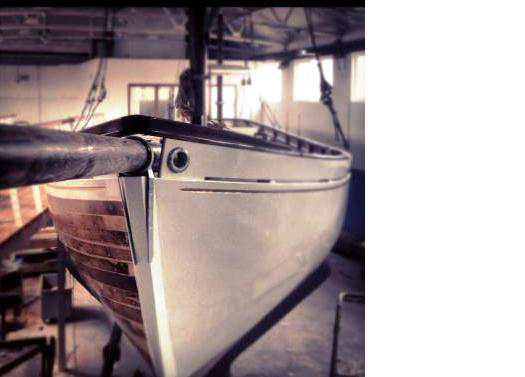
Asgard I pictured above, Celtic Mist in main image
Two boats, part of the Irish maritime scene in years past, are back in public – Asgard 1 and Celtic Mist – one ashore, the other afloat.
I was in the National Museum at Collins Barracks in Dublin when the historic ketch of Erskine and Mollie Childers went on exhibition after a five-year restoration project. It will be a permanent reminder of how the marine sphere was central to the formation of this Republic. Asgard looks superb. There was a lot of controversy over whether she should be restored or put to sea again, but the right decision has been made to conserve her ashore. The exhibition is open free-of-charge and worth seeing.
The second vessel, Celtic Mist, is the motor-sailing ketch of Charlie Haughey which his family donated to the Irish Whale and Dolphin Group. I was asked to re-dedicate it to its new role as a research vessel and did so on Sunday at Kilrush Marina, where hundreds watched the ceremony. I talked to Conor Haughey who told me: "They have rejuvenated her. She was getting old and tired and it would have been a shame if she rotted away rather than going to sea again. The boat was very important to my father. It has great family memories."
Onboard, Charles Haughey's cabin has been dismantled, including the bath and double berth and several bunks built instead for researchers who will track whales and dolphins and carry out other maritime research. Much of the eight-month refurbishment work was done by IWDG volunteers, with some contractors and financial assistance from the Clare Leader organisation and other supporters.
Despite all the controversy surrounding Haughey, as IWDG Director Simon Berrow said, getting the boat was a major benefit and came in the 21st year of its existence. In government Haughey had declared Ireland's waters a whale and dolphin sanctuary and Dr.Berrow said this should be followed by a
similar "pan-European designation" of EU waters. The Celtic Mist will provide a platform for finding out more about whales and other marine life off Ireland, he said.
JOHN TWOMEY AND THE IRISH PARALYMPIAN SAILORS

Irish Sonar Team
Kinsale Yacht Club member John Twomey is leading his crew into his tenth consecutive Paralympics, a magnificent achievement for the 57-year-old sailor. He will Skipper the Sonar, Ireland's only sailing entry, with crew Anthony Hegarty and Ian Costelloe. Sailing will be in the testing waters of Weymouth Bay on the south coast of England where the Olympic events were also held.
For the past three and a half decades he has been one of Ireland's most consistent and successful performers at the Paralympic Games. John is already the holder of Paralympic medals, won prior to his sailing career in the discus event - bronze in 1984 and gold at Seoul 1988. He also competed in table tennis before his transition to sailing, winning silver in the team event at Arnhem in 1980. Before moving to the three-man Sonar keelboat he sailed with Amy Kelleher in the mixed SKUD18 event at Beijing 2008, finishing tenth with a score of 75 points.
In preparing for this year's Paralympic John, Anthony and Ian were 7th in the World Disabled Sailing Championships in Florida and have been practising intensively off Kinsale over the past few weeks.
I met him at Kinsale YC and he was hopeful about their prospects:
"Tough waters in Weymouth, but with the experience of the past few months, particularly in the world championships we are well prepared."
John is from Ballinhassig, has represented Ireland more times than any other Olympic or Paralympic athlete. He is involved in sailing courses in Kinsale for people with disabilities where up to 30 sailors with a wide range of physical, intellectual and sensory disabilities go sailing every Saturday.
In Paralympic Sailing, three medal events feature one, two and three sailors per boat, respectively. All events consist of nine separate races with one point for first, two for second and so on, the same as in Olympic sailing. The winner has the lowest points total at the end of the nine races.
John's crew mates are 42-year-old Anthony from Mallow and 24-year-old Ian from Killorglin in County Kerry. Both are both amputees. John introduced Anthony to sailing seven years ago. He works as a software developer for Core International and has represented Ireland on several occasions. He is also a member of Kinsale Yacht Club.
Ian also sails out of Kinsale YC and will be making his first appearance at the Paralympic Games.
Paralympics Ireland CEO and Chef de Mission for the Irish Team, Liam Harbison, said there has been tremendous preparation, co-ordination and management of the Irish Team. "It's time for us to make a return on the faith and investment placed in us – we aim to deliver."

From left: John Twomey, Ian Costelloe and Anthony Hegarty.
NEW PILOT BOAT IN CORK
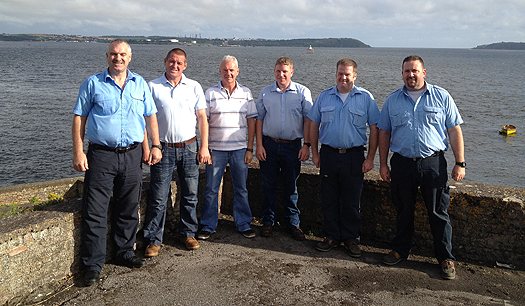
Cork Pilot Boat Crew
Cork Port has a new pilot boat. 'Failte' was built by Safehaven Marine and replaces 'Sonia' which has been in service for 14 years. Safehaven Marine is a Cork -based company, employing 25 staff in Little Island and Youghal. Since the company was founded in 1998. They have supplied pilot boats to countries from Scandinavia to the Middle East and are one of Europe's leading manufacturers of GRP pilot boat.
There are eight full-time crew, six of them pictured here – L to R: Ron Randalls, Carl Randalls, Gerry Moran, George Norris, Con Crowley and Keith Ryan. (Two were on holiday when the photo was taken.) The boat is an Interceptor 48 with two Volvo D13 engines, 600 hp each.
Cork pilot boats undertake in excess of 3,000 services per annum to vessels of all types including cruise ships and cargo vessels, according to the port company.
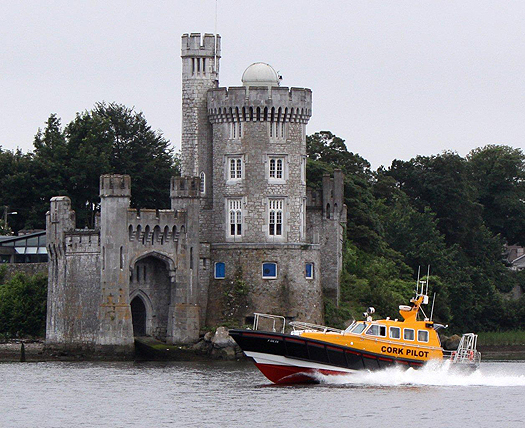
MAKING PILOTING SAFER
The International Maritime Pilots' Association and the International Chamber of Shipping have joined forces to update a brochure aimed at shipping companies and seafarers to ensure that ladders used for pilot transfers are safe and always rigged correctly.
The revised brochure – 'Shipping Industry Guidance on Pilot Transfer Arrangements' – is supported by a wide range of other international shipping bodies. It takes account of the latest amendments to the Safety of Life at Sea Convention (SOLAS) concerning pilot ladders, which came into effect on 1 July 2012.
IMPA Secretary General, Nick Cutmore, said: "Pilots continue to lose their lives as a result of accidents while boarding or disembarking from ships, and many more have been seriously injured."
ICS Secretary General, Peter Hinchliffe, added: "Some common causes of accidents still appear to be defects in the structure of the ladder treads or ropes, or a lack of a proper securing of the ladder to the ship."
An electronic copy of the IMPA/ICS brochure can be downloaded from the IMPA and ICS websites.
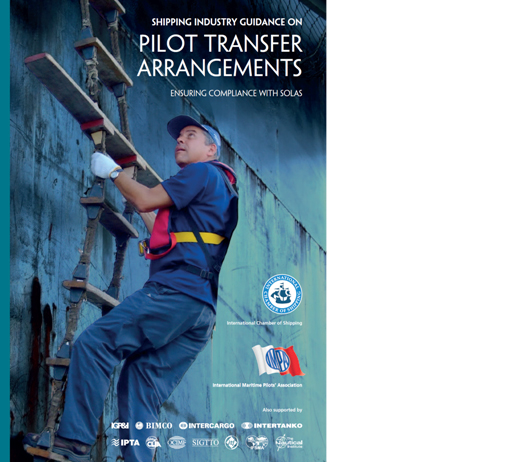
New Pilot Boarding Advice
--------------------------------------------------------------------------------------------------------
Email your comments on items in TIN develop maritime discussion to: [email protected]
Follow me for more maritime news and comment on Twitter: @TomMacSweeney
And on Facebook – THIS ISLAND NATION page
Lifejackets Save Lives - UK Coast Guard
#LIFEJACKETS – There were 95 maritime deaths in the UK in the last five years which might have been prevented if those involved had been wearing a lifejacket or buoyancy aid. These figures were collated following the annual meeting of the Casualty Review Panel in March.
The panel looked at fatal maritime incidents for 2011 and, where there was sufficient information, assessed whether it was probable, possible or unlikely that the person involved could have been saved had they been wearing a lifejacket or buoyancy aid.
In 2011, the panel judged that of the incidents that they considered, it would have been appropriate for 18 people to have worn some form of buoyancy. Of these, 13 would probably or could possibly have been saved had they been wearing a lifejacket or buoyancy aid. Between 2007-11 the panel considered 120 fatalities and in 95 of these cases a life could probably or might possibly have been saved had the person involved been wearing a lifejacket or buoyancy aid.
Commercial fishing and angling are the two riskiest activities where lives might be saved by buoyancy-wear, according to the figures collated by the panel over the last five years.
Transferring between your vessel and the shore is particularly hazardous. Twelve people died boarding or alighting during 2011 and the risk is increased further following alcohol consumption. Eight of these twelve had been drinking before they returned to their vessel. Transferring between a vessel and the shore is a situation where one would not normally be expected to wear a lifejacket or buoyancy aid. Further research will be undertaken regarding this issue.
Operation Underway to Remove Fuel from Grounded Vessel
#COAST GUARD – The operation to remove the remaining 24,000 litres of fuel oil, along with oily water and other hazardous materials from the grounded vessel 'Carrier' was completed yesterday evening.
The vessel, which ran aground on 4 April near Llanddulas in North Wales, remains aground and is resting against concrete dolosse blocks on the beach close to the North Wales Expressway (A55). The owners of the vessel have declared it a Constructive Total Loss.
On Saturday, PGC Demolition, the same company who were awarded the contract to remove the fuel oil from the vessel, were also awarded the contract to remove the wreck of the vessel. Their proposals to cut the vessel up on site and remove it for recycling have been approved by the Deputy to the Secretary of State's Representative for Maritime Salvage and Intervention, with work expected to start tomorrow and last for a period of up to ten weeks.
County Down Coast Guard is Recognised for Rescue
Coastguard Rescue Officer Keith Campbell has been recognised for his part in the rescue of four people trapped in water on an incoming tide in Dundrum Bay, County Down on 9 July 2011.
Four teenagers found themselves cut off by the tide and up to their shoulders in water while walking from Ballykinler to Dundrum. They called 999 and whilst the rescue teams were on their way to the scene, Keith, a former Coastguard Rescue got his dinghy into the water and rescued the teenagers from the water.
In total the efforts of five individuals are to be recognised by the award of the Chief Coastguard’s Commendations 2011.
Ian Deakin from the Newhaven Coastguard Rescue Team received his award, for saving the life of a 19 year old man from heavy seas at Newhaven, on 8 June 2011.
The team was called to Splash Point near Seaford in East Sussex following a 999 call reporting a man face down in the water. Newhaven Coastguard Rescue Team was first to arrive on scene and, realising that time was of the essence, Ian went out and quickly brought the man to shore where he was resuscitated.
The Chief Coastguard’s Commendations have also been awarded to:
Peter Thomson of MRCC Aberdeen for his 25 years of outstanding contribution to the work of HM. Coastguard;
John Kirkpatrick, CRO, for his part in the rescue of two adults and six children who were stranded on a rising tide in Dundrum Inner Bay, County Down on 27 April 2011;
Adrian Sanderson, DSO, for his part in the recovery of a person from the water off Cleethorpes on 19 November 2011.
Rod Johnson, Chief Coastguard said:
"Peter, Ian, John, Adrian and Keith have acted in the highest traditions of the service.
"In commending these officers I’d also like to take the opportunity to recognise the outstanding work done by all of our officers every day and often in the face of adversity. Well done, and thank you."
Damaged Cargo Ship Remains Aground
The cargo ship 'Carrier', which ran aground at 8.15 last night (Tuesday) at Raynes Jetty in Llanddulas remains hard aground in the same location with damage to its starboard side. A quantity of marine gas oil has leaked from the vessel.
The 'Carrier' has been holed in three places on the starboard side. It's reported that the port side, where the fuel tank is located, is intact.
Officers from the Maritime and Coastguard Agency's Counter Pollution and Salvage branch are working with all agencies on plans to remove the fuel as soon as possible.
Vessel Aground at Llanddulas
At 8.15 last night Liverpool Coastguard received a distress call from the cargo ship 'Carrier' telling them they had run aground at Raynes Jetty, Llanddulas.
A strong gale was blowing and a five metre swell was reported. Because of the location of the grounding Holyhead Coastguard coordinated the rescue. All seven of the Polish crew were taken uninjured from the ship by two rescue helicopters (the first from RNAS Prestwick, the second from RAF Leconfield).
The A55 was closed to allow the rescue services safe access to the vessel. Coastguard Rescue teams from Rhyl and Llandudno offered assistance to the rescued crew whilst the RNLI lifeboats from Llandudno and Rhyl launched.
The vessel is now resting against concrete dolosse* blocks on the beach at Llanddulas, which runs adjacent to the A55. Coastguard Rescue Officers, North Wales Fire and Rescue Service, Ambulance and Police are currently on scene with the Highways Agency. Salvage and counter pollution experts will be on site in the morning.
Coastguard Takes Delivery of New Chopper
#COASTGUARD – The Irish Coast Guard took delivery of its new search and rescue helicopter at its Shannon base in late January.
Production of the Sikorsky S-92 was completed last year under the rescue service's €500 million deal with CHC Ireland to revamp its aircraft fleet.
The US-based helicopter firm and CHC formalised the purchase on 21 December with Irish Coast Guard director Chris Reynolds during a hand-over ceremony at the S-92 assembly facility in Coatesville, Pennsylvania.
Equipped for dedicated search and rescue (SAR) operations, the helicopter will provide coverage for deep Atlantic Ocean missions, service Ireland's offshore islands and provide rescue cover on the west coast from Cork to Galway.
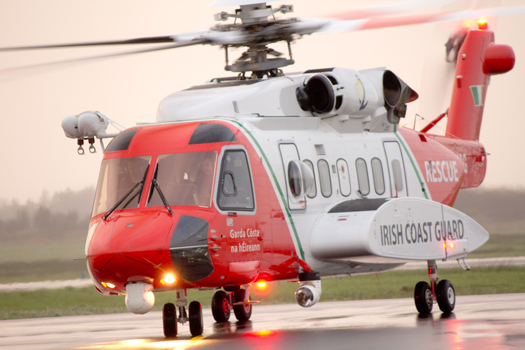
According to Sikorsky, the S-92 features advanced systems and hardware, including an automated flight control system that enables the pilot to fly pre-programmed search patterns and perform delicate hover manoeuvres; a wireless intercom allowing a rescue swimmer to communicate with the crew; radio transceivers to communicate with ships and rescue services; a weather radar and infrared sensor; and a digital video system to record rescues.
Training with crews at Shannon began in Februarty ahead of the S-92's first public demonstration at the centenary of the Titanic's departure from Cobh.
The 10-year deal with CHC will also see the coastguard's remaining four Sikorsky S-61s replaced by second-hand S-62s from Scotland over the coming months.
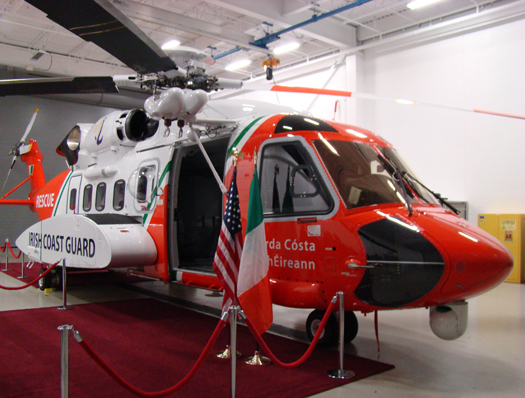
Meanwhile, it is expected that the Air Corps may be offered an upgraded air ambulance role, after they were ruled out as contenders for search and rescue work amid some controversy.
Body of Man Recovered Near Dundalk Lighthouse
#LIFEBOAT – The body of a man who had been in a small boat that capsized was recovered a mile offshore and close to Dundalk lighthouse yesterday.
It is understood the man had taken a small punt out from Soldiers Point to reach another boat at about 3.45pm but went missing after he capsized. There was nobody else on board and weather conditions were said to be calm.
An extensive search was launched involving various Coast Guard units, Clogher Head RNLI and Dundalk Sub Aqua Club.
The Irish Indepdent has more on the story here.




























